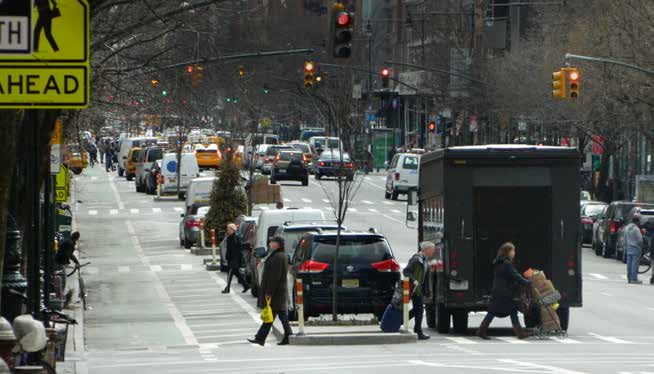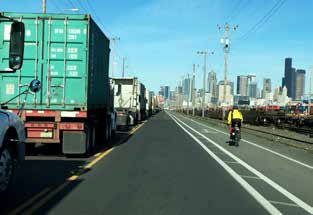Primer for Improved Urban Freight Mobility and Delivery
Operations, Logistics, and Technology Strategies
3. Logistics Strategies and Noteworthy Practices

New York City streetscape. Source: Alison Conway, City University of New York.
The following section presents four strategies geared towards improving the operation of freight and goods movement in urban areas. In the following pages, each strategy is profiled as a noteworthy practice, featuring a notable example of the strategy being implemented in the U.S. or abroad.
The four strategies discussed in this section include off-hours delivery, pick-up/delivery reservation systems, modal shifts, and freight consolidation. These strategies are typically pursued by private sector stakeholders with the goals of improving their supply chain efficiency and reducing the costs associated with delays, congestion, and ticketing. Logistics strategies also help address issues with mobility and traffic flow, communication between shippers and receivers, and quality of life and community benefits in residential areas. These types of strategies can also lead to new freight delivery technologies that can be applied in a variety of contexts.

Trucks and a bicyclist share a road leading into Seattle. Source: Chris Eaves, Seattle DOT.
Off-hours delivery strategies can help to reduce freight contributions to traffic congestion and reduce competition for parking. However, these strategies need to address residential concerns regarding noise and must be closely coordinated with receivers. Advance pick up/delivery reservation systems can be used to shorten loading times and provide solutions to parking, congestion, and security issues.
Where feasible, shifting freight off of streets and highways and on to rails or waterways can reduce wear and tear on roadways and improve the efficiency and reliability of freight movements. Consolidating planned freight movements to reduce the number of shipments requires planning and coordination, but can reduce the negative impacts of freight deliveries on traffic and residents.
Private sector stakeholders that pursue logistics strategies to better adapt to urban areas should engage with not only shippers, receivers, trucking/logistics companies, and other industry stakeholders, but also with local and public sector stakeholders that may be either positively or negatively impacted by any changes to a supply chain or delivery method. The end goal for all stakeholders is to minimize external conflicts while maximizing cost savings and efficiency.